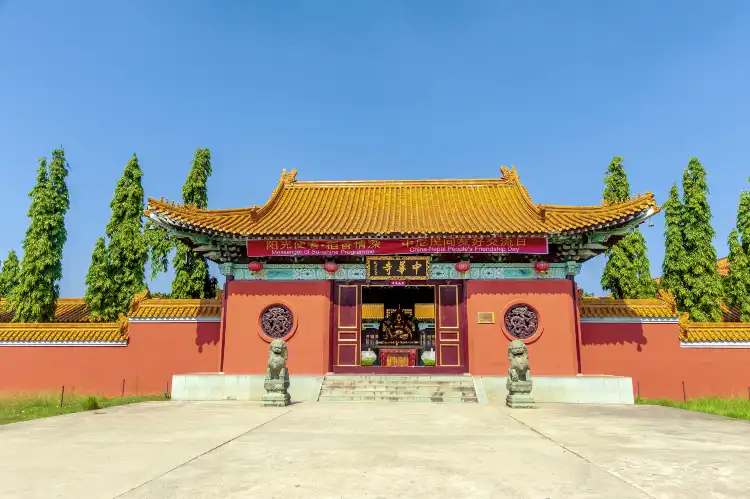
Find the Cheap Lumbini Sanskritik Hotels
Enter your dates for the latest hotel rates and availability.
Hot travel dates
Today
Tomorrow
Next Weekend
Feb 2025
- Mon
- Tue
- Wed
- Thu
- Fri
- Sat
- Sun
- 1
- 2
- 3
- 4
- 5
- 6
- 7
- 8
- 9
- 10
- 11
- 12
- 13
- 14
- 15
- 16
- 17
- 18
- 19
- 20
- 21
- 22
- 23
- 24
- 25
- 26
- 27
- 28
Mar 2025
- Mon
- Tue
- Wed
- Thu
- Fri
- Sat
- Sun
- 1
- 2
- 3
- 4
- 5
- 6
- 7
- 8
- 9
- 10
- 11
- 12
- 13
- 14
- 15
- 16
- 17
- 18
- 19
- 20
- 21
- 22
- 23
- 24
- 25
- 26
- 27
- 28
- 29
- 30
- 31
Swipe up to view more
Filter by:
Hotel Star Rating
≤2345
Popular Filters
Amazing 4.5+Great 4.0+Good 3.5+Pleasant 3.0+We found 28 hotels for you in Lumbini Sanskritik
Choose your travel dates to see the latest prices and deals.
Most Booked
Lowest Price
Closest to Downtown
Highest Rated
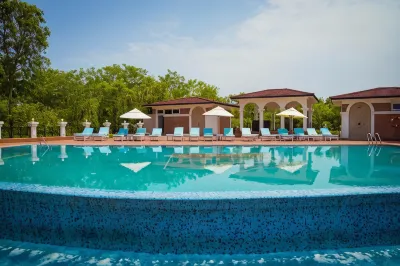
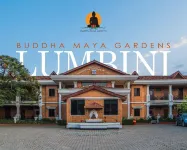

Hotel near Lumbini Sanskritik
YYI 2019.12.16
It's pretty good in Lumbini. To be honest, I live very comfortably. It has nothing to do with not being scored 5 points. It is recommended.
The service score was low because a male staff member at the front desk of the hotel, about 30 years old, helped us find a local ”Tutu” car. He started to say 100 rupees, and it cost 1,000 to return to the hotel after using the car. Don't we understand the difference between 100 and 1000? It's ridiculous. Rs 900 is just 50+ RMB.
Angrily complained to Ctrip, Ctrip handled it very well, with 100 points.
Lament the greatness of the motherland!
No matter Nepal or Bhutan, there are good people and people who are not bad people. I once again lament the greatness of the motherland.
12 reviews
3.8/5
Price from
CAD 78
per night



Hotel near Lumbini Sanskritik
Mmarqoos_pl 2020.03.28
LOCATION & ATTRACTIONS NEARBY *** Located in the main part of Lumbini town, just few steps away from one of the gate to get to the Maya Devi Temple and Old Shakya Temple. It’s literally few minutes away, walking. After that, I recommend to negotiate an auto-rikshaw (they have electric ones now) to see all other temples and the World Peace Pagoda (distances are huge, so this is very efficient way to do it), it’s not expensive and definitely more comfortable. Also, if you’re travelling by bus, they will be probably stopping somewhere in the area. There are some food and souvenir shops just 2 min away from the hotel. HOTEL OVERVIEW *** It is quite basic hotel, not very pretty (like most buildings in Lumbini), built in a bit chaotic style (outside). If you’re travelling by car, you can leave it in front of the hotel or in the secured place behind the hotel (behind the gate). PURPOSE OF THIS TRIP *** Leisure RESERVATION *** Via ebookers.ie (expedia) as they offered the best pre-paid rates. LENGTH OF MY STAY *** 1 night – Mar 2019 CHECK-IN *** We arrived in the early evening after long and tired full journey from Kathmandu (I was driving myself). The amount of dust we consumed on the way was unbelievable. So what we needed, was a quick check-in and shower. We’ve been accommodated immediately and helped with our luggage. Rooms were allocated as requested as we’re travelling with friends. Check-in was quick and hassle-free. We’ve been advised of the meal options and what / when / where to go the next day. I also requested if they have somebody to help with the car wash (yes, unusual request, but my car was actually covered in 1 cm layer of dust) and they helped with it (of course I paid for it as intended). LOBBY & RECEPTION *** Small reception where you can also get some drinks. There’s restaurant attached to it where we decided to have our dinner. Menu was quite simple, but good choice and food was delicious. We were very happy with this choice. ROOM *** Standard Rooms #203 & #202 were allocated for us. Rooms were quite small and basic, but this is exactly what I paid for. I have to admit, the price we paid was silly low, so I wasn’t expecting any luxurious. Room was clean and fresh, with two beds (quite hard mattress’). Air-conditioner unit was quite noisy, but the fan was absolutely fine most of the time. There was small wardrobe, mirrors and coffee/tea making kit. Complimentary 2 bottles of water were also provided. As I said, nothing special (this is not a luxury hotel), but more than I expected and paid for. BATHROOM *** Similar to the room, standard, but clean. Some soap was provided, but you may consider having your own toiletries. BREAKFAST *** We paid for the breakfast in the hotel and this was very good idea. The selection was enough and same as dinner, quite tasty. Definitely recommend doing it instead of walking around and trying to find something else. No point of wasting your time. INTERNET
Very Good
8 reviews
4.0/5
Price from
CAD 25
per night

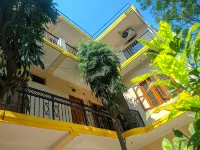
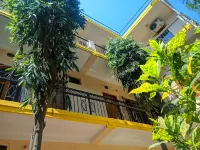
Hotel near Lumbini Sanskritik
GGuest User 2020.01.23
The rooms are small but tidy. Accommodations near Lumbini Park are average. This hotel is very cost-effective. The air conditioner in the room is brand new and very easy to use. The quilt in the room is a reusable blanket. It is recommended to bring your own travel bedding. A very cute family runs this hotel and chats very happily.
14 reviews
3.9/5
Price from
CAD 12
per night

You Might Like
Hotels With BreakfastHotels With Twin RoomHotels With 1 Double BedHotels With Swimming PoolHotels With Free Cancellation
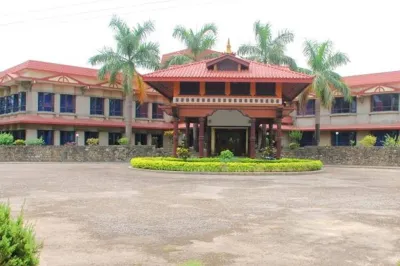
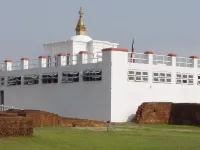

Hotel near Lumbini Sanskritik
2023.03.07
It is difficult to review this hotel without being truthful and yet, I do not wish to spoilt the business. So for what it is, here are the truths. Bedroom is decent size, aircon fairly strong and wifi is good. There are many plugs for your devices, and the in-house water comes in Glass Bottles (but there’s probably the only saving grace for this hotel). However there are Stained toilet bowl, there is no bidet, and the flush is not working, shower stand under bathtub and i can’t figure out how to get hot water, i let the water run to get hot water but it doesn’t to work. I highlighted to the team member and they get it fixed. Here, the staff are helpful to make things work for you, and I give them credit for it. Due to the low occupancy, breakfast was a set meal option, but it came in big portion and tasty. The hotel probably need more customers for the fund to renovate itself, but yet at the current stage it is difficult to recommend this hotel.
4 reviews
3.3/5
Price from
CAD 116
per night



Hotel near Lumbini Sanskritik
Located in Lumbini, Hotel Ratnasambhava is within a 15-minute walk of Sri Lankan Monastery and Gautami Nun’s Temple. This hotel is 0.9 mi (1.4 km) from Golden Temple and 1.1 mi (1.7 km) from Royal Thai Buddhist Monastery.
Take in the views from a terrace and a garden and make use of amenities such as complimentary wireless internet access.
A complimentary continental breakfast is served daily from 7:00 AM to 10:00 AM.
Featured amenities include dry cleaning/laundry services, a 24-hour front desk, and luggage storage. Free self parking is available onsite.
Make yourself at home in one of the 45 air-conditioned guestrooms. Complimentary wireless internet access is available to keep you connected.
3.9/5
Price from
CAD 62
per night

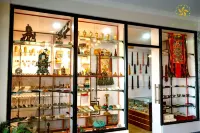
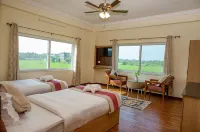
Hotel near Lumbini Sanskritik
2024.08.13
Five Elements was my highlight in Lumbini. My room was spacious and the AC was excellent and rescued my stay in hot Lumbini, which is definitely worth a visit but during the dry season you should definitely stay at a clean, modern hotel, such as Five Elements, that is well equipped with comfy big beds with exquisite cotton duvets and soft dreamlike pillows and covers. The bathroom has got everything you need and on top a water jet of high pressure - something I miss so often in hotels! The location is perfect because it is a bit back from the main road. My sleep was brilliant and I also enjoyed the quality of my food served by friendly helpful staff. It isn’t far from the beautiful Maya Devi Temple, which I liked best. Actually, this hotel isn’t far from any attraction in Lumbini. All in all, I can only recommend staying there, booking was easy, without complications of any kind. I can say that Five Elements made my stay😊 Thank you 🙏 very much everybody.
Very Good
13 reviews
4.0/5
Price from
CAD 64
per night

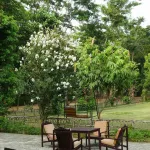
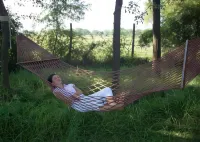
Hotel near Lumbini Sanskritik
GGuest User 2023.09.17
Rumbini Buddha garden resort is not only a hotel but also a beautiful garden with lotus pond , surrounded by lawns and forests, I really appreciate staff members of the hotel, they are so kind and sincere, helping me a lot in many ways, ready to offer what you need instantly. The room is clean, spacious and good light with morden facilities like Ac, hot shower, fast WiFi. It has two baconies where you can watch views and relax and dry your clothes. They are very considerate when cleaning rooms, even helped to fold my messy clothes and shoes, and to put back the clothes you dried in the bacony into the room, keeping everything tidy and nice. The food was very delicious too, I asked them to send to my room, they are very patient, packed the food carefully and delivered with the whole set of delicate dishes, glasses, spoon, knife and so on. In the morning you can hear the birds singing and the staff are diligently doing gardening, cleaning, washing. They even bow down to wipe the bricks of the road leading to room buildings in the garden which touches and impresses me. I am really grateful to all those who have served and helped me with warm hospitality and patience. I highly recommend Rumbini Buddha garden. It's a wonderful choice when you you are in Lumbini.
Excellent
45 reviews
4.5/5
Price from
CAD 79
per night


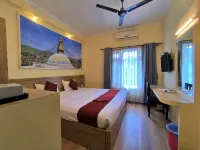
Hotel near Lumbini Sanskritik
GGuest User 2023.08.18
#positive #I was happy with the Location, Nearby Activities, Mosquito Control Measures, Soundproofing, Safety; #negative #I was disappointed with the Room Size; My family and I stayed at Peaceland hotel in Lumbini for six days. The service here was very good and met all our needs.
Location: Next to the Maya Devi Temple. Reception helped us call a tuktuk, which is a large tricycle in China. It costs 1,000 Nepalese rupees a day and can go around all the temples in various countries. If you have enough time, it is recommended to experience taking a boat. It costs 100 Nepalese rupees per person for a round trip.
Meals: The restaurant in the hotel has a good environment, but there is no Chinese food. You need to remind yourself no spicy, otherwise almost all dishes will be spicy. Nepalese seasonings will have spicy taste. There are many restaurants nearby. Children like to eat tomato scrambled eggs in Chinese restaurants.
Room: The standard room we booked is small but very clean. The room facing the street at the beginning was too noisy, so they helped us change to a quiet room. The facilities are a bit old and the TV is a bit small, but you can watch YouTube online and Chinese programs can be seen.
Service: Perhaps it was influenced by a good saying on the wall, Jingsiyu, that I cannot be missing someone when doing good things, and I cannot be more when doing bad things. The staff here are very nice and they will do their best to meet the needs of customers.
A hotel worth recommending and will come again.
Very Good
18 reviews
4.0/5
Price from
CAD 36
per night


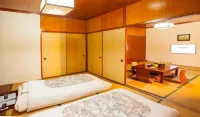
Hotel near Lumbini Sanskritik
YYAMT 2023.06.25
It is within walking distance from the Buddhist Park. It is actually at Gate 2 of the park. The location is very good. The hotel is well planned, the environment is elegant, the red brick building is fully integrated into the Buddhist park, and the service staff are warm and friendly. The hotel has a history of more than 30 years. The rooms are designed by the Japanese, and the layout is full of Japanese style. Although the maintenance is good, the facilities are too old after all. The cooling capacity of the air conditioner is limited. I don’t know if it’s because of the low season. On the first day we arrived at the store, there were no other guests in the huge hotel. There were less than 10 staff members serving the guests in one of our rooms. On the second day, the other room seemed to be occupied. The hotel does not provide hot water for bathing, but because of the hot weather, the problem is not too big. There are no other commercial facilities around. If you don't want to call a car, you can only have meals at the hotel, and the price is normal.
Outstanding
22 reviews
4.6/5
Price from
CAD 104
per night



Hotel near Lumbini Sanskritik
When you stay at Hotel Siddhartha In Lumbini in Lumbini, you'll be in a provincial park, within a 15-minute walk of Maya Devi Temple and Ashoka Column. This hotel is 0.7 mi (1.2 km) from Gautami Nun’s Temple and 0.8 mi (1.2 km) from Sri Lankan Monastery.
Make use of convenient amenities such as concierge services, gift shops/newsstands, and a television in a common area.
Grab a bite to eat at one of the hotel's many dining establishments, which include 20 restaurants and 10 coffee shops/cafes. Need to unwind? Take a break with a tasty beverage at one of the 20 bars/lounges. Continental breakfasts are available daily from 7:30 AM to 9:00 AM for a fee.
Featured amenities include a computer station, dry cleaning/laundry services, and a 24-hour front desk. Free self parking is available onsite.
Make yourself at home in one of the 23 guestrooms. Complimentary wireless internet access is available to keep you connected. Conveniences include ceiling fans, as well as phones with free local calls.
Check Availability
What travellers say about Lumbini Sanskritik attractions
Discover these places worth visiting in Lumbini Sanskritik and select a hotel nearby for ultimate convenience
Lumbini
RRam Prasad PantaLumbinī , "the lovely") is a Buddhist pilgrimage site in the Rupandehi District of Lumbini Province in Nepal. According to the sacred texts of the Buddhist Commentaries, Maya Devi gave birth to Siddhartha Gautama in Lumbini in c.624 BCE. Siddhartha Gautama achieved Enlightenment, and became Shakyamuni Buddha who founded Buddhism. He later passed into parinirvana at the age of 80 years, in c.544 BCE. Lumbini is one of four most sacred pilgr
Maya Devi Temple
郭郭润龙浪迹天涯20240611pm:
1. Mahamaya Temple is located in Lumbini Park. Lumbini is a Buddhist holy place in Nepal. It is the birthplace of Buddha Sakyamuni. It is a garden built by Sakyamuni's father King Suddhodana for his wife Queen Maya 2,500 years ago. It was selected into the World Cultural Heritage List in 1997. The existing protection park was built in 1986 and expanded into a concentrated display area of Buddhist buildings in many countries, covering an area of about 8 square kilometers. The scenic area is divided into three major areas: Mahamaya Temple, temple areas of various countries, and green squares. It is a good place to worship Buddha, pray, learn humanities, and take photos. In history, there are footprints of celebrities such as Sakyamuni, Ashoka, Xuanzang, and Faxian.
2. Mahamaya Temple is the birthplace of Sakyamuni. In 563 BC (the ninth year of King Ling of Zhou during the Spring and Autumn Period), Mahamaya of Kapilavastu in northern India passed by this garden when she was returning to her parents' home. She was attracted by the beautiful scenery and stayed here. The next day, she gave birth to Gautama Siddhartha. Because he was a member of the Sakya clan, he was later honored as Sakyamuni, which means "the saint of the Sakya clan". After that, believers built a temple here. Later, the temple was destroyed and only the foundation remained. The current temple area was rebuilt in 1990 and took 3 years to complete. From the outside to the inside, there are:
① Shoe storage: You have to take off your shoes when entering the temple. The shoe storage rack and foot washing faucet are located outside the temple. The tour guide said that there are professional shoe thieves here, so the driver was arranged to help everyone watch. In summer, the floor tiles are very hot in the sun
② Main building: a white square single-story building. Photography is prohibited indoors. The lowest level is the ruins of the ancient temple. A pedestrian corridor is built around the ruins. In the middle is the birthplace of Sakyamuni. The footprints of Sakyamuni are covered by a glass cover on the ground. The soles of the feet are relatively large. There is a mat next to it for meditation. It only takes 5-10 minutes. In 403 (the second year of Daheng in the Eastern Jin Dynasty), the monk Faxian came here for pilgrimage and was recorded in the "Biography of Faxian". He was the first person in my country to come here for pilgrimage since records. ③ The ruins of the original temple: dark red, it is the original stone foundation from 2,500 years ago, both indoors and outdoors of the main building. The entire foundation outdoors is staggered, with a good visual effect. There are no protective measures for the ruins, but you cannot step on it. A sign prohibiting short video shooting "No Tik Tok" has also been erected. ④ The twin sala trees: thick ancient trees located outside the main building. Sakyamuni was born under the twin Sahasrara trees. The original trees have long since died, but this tree is also very old. The sunken part of the trunk facing the main building has become a natural Buddhist shrine. Many of the blessing trees around are hung with colorful flags, similar to the colorful prayer flags in Tibet. In the order of blue, white, red, green and yellow, they represent the blue sky, white clouds, flames, green water and yellow earth. ⑤ Bathing pool: A large square pool of 10 square meters, where Mahamaya bathed in the past. There are fish and turtles in the pool. On the shore is a pigeon feeding platform
⑥ Ashoka Pillar: It was built around 200 BC by Ashoka, the emperor of the Maurya Dynasty of India and one of the "100 emperors who influenced the world", when he came here to worship. It is 7.79 meters high and more than 2 meters in circumference. In 635 (the ninth year of the Zhenguan period of the Tang Dynasty), the monk Xuanzang saw the Ashoka Pillar when he came here to worship and recorded it in "The Great Tang Records on the Western Regions". It collapsed later and was discovered in 1896.
Zhong Hua Monastery
郭郭润龙浪迹天涯20240611 In the afternoon: 1. The Chinese Temple is located in the Temple of the Mosman Moyer in Lambini Garden. Lambini is a Buddhist holy place in Nepal, the birthplace of Buddha Sakyamuni, the garden built by Sakyamuni's father, King Jingfan, for his wife, Queen Moye, 2,500 years ago, was selected in the World Cultural Heritage List in 1997, and the existing conservation park was built in 1986. It has been expanded into a centralized display area of Buddhist architecture in many countries, covering an area of about 8 square kilometers. The scenic spot is divided into three major areas of the Mosman Moye Temple, temple areas of various countries, and green squares. It is a good place to worship Buddha, study humanities, and view photography. There are famous footprints such as Sakyamuni, Ashoka, Xuanxuan, and Faxian in history. ① Address: Lambini Village, Nepal ② Transportation: No bus, easy to drive ③ peak season: no ④ Time: 4 hours ⑤ Ticket price: 700 rupees (39 yuan: This is the price of foreigners, the price of each country is different, Nepalese and Indians are close to free) 2. Temple Areas of the countries are a collection of temples built by Buddhist organizations in response to the United Nations, which gathers Buddhist temples of different styles in various countries, including 29 Mahayana Buddhist temples and 13 Mahayana Buddhist temples, of which Mahayana Buddhist temples are more spectacular and beautiful, and each temple will close for lunch at 12:00. This area is large in size and can employ human tricycles to shuttle around, each car can seat 4 people. 3. China Temple: China assisted in construction, built in 2000, covering an area of 2.56 10,000 ㎡, is the first temple built overseas in China, named by Zhao Puchu, president of the Chinese Buddhist Association and handwritten , the temple is the Forbidden City style of red wall yellow tiles, the temple is from the outward to the inward is the Ben Huan Jin statue (modern high monk), Xuanpu Station statue, a pair of stone lions (the lion on the left side is the male, the mother on the right side is the ball), the Temple of Heavenly Kings (for the Maitreya Buddha, the Vetuo Bodhisattva, the four kings), the Temple of the Great Xiongbao (for the Sakyamuni), the Fatang/Tibetan Jingge, the abbot's room. The temple is the only temple nearby that does not need to take off shoes.
Lumbini Museum
郭郭润龙浪迹天涯20240611 In the afternoon: 1. The Lumbini Museum is located in the Temple of Madame Mamoye in Lumbini Garden. Lambini is a Buddhist holy place in Nepal, the birthplace of Buddha Sakyamuni, the garden built by Sakyamuni's father, King Jingfan, for his wife, Queen Moye, 2,500 years ago, was selected in the World Cultural Heritage List in 1997, and the existing conservation park was built in 1986. It has been expanded into a centralized display area of Buddhist architecture in many countries, covering an area of about 8 square kilometers. The scenic spot is divided into three major areas of the Mosman Moye Temple, temple areas of various countries, and green squares. It is a good place to worship Buddha, study humanities, and view photography. There are famous footprints such as Sakyamuni, Ashoka, Xuanxuan, and Faxian in history. ① Address: Lambini Village, Nepal ② Transportation: No bus, easy to drive ③ peak season: no ④ Time: 4 hours ⑤ Ticket price: 700 rupees (39 yuan: This is the price of foreigners, the price of each country is different, Nepalese and Indians are close to free) 2. Lambini Museum: strange and beautiful in appearance, Like several red stereos arranged, the second floor, the interior displays the archaeological finds of Lumbini, Sakyamuni and Nissan. The museum is closed on Tuesday.
Ashoka Pillar
郭郭润龙浪迹天涯20240611 In the afternoon: 1. The stone pillar of King Ashoka is located in the Temple of Madame Mamoye in Lambini Garden. Lambini is a Buddhist holy place in Nepal, the birthplace of Buddha Sakyamuni, the garden built by Sakyamuni's father, King Jingfan, for his wife, Queen Moye, 2,500 years ago, was selected in the World Cultural Heritage List in 1997, and the existing conservation park was built in 1986. It has been expanded into a centralized display area of Buddhist architecture in many countries, covering an area of about 8 square kilometers. The scenic spot is divided into three major areas of the Mosman Moye Temple, temple areas of various countries, and green squares. It is a good place to worship Buddha, study humanities, and view photography. There are famous footprints such as Sakyamuni, Ashoka, Xuanxuan, and Faxian in history. ① Address: Lambini Village, Nepal ② Transportation: No bus, easy to drive ③ peak season: no ④ Time: 4 hours ⑤ Ticket price: 700 rupees (39 yuan: This is the price of foreigners, the price of each country is different, Nepalese and Indians are close to free) 2. Madame Malamoyeh Temple is the birthplace of Sakyamuni. In 563 BC (nine years of Zhou Lingwang in the Spring and Autumn Period), Mrs. Malamoyeh of the Northern Tianyu Kapilo Weiguo, when she returned to her mother's house, passed by this garden and was attracted by the beautiful scenery, so she lived here. The next day, she gave birth to Qiao Damo here. Siddhartha, Because it is a Sakya people, later honored Sakya Hani, meaning "Sakya saints." Since then, believers have built a temple here, the temple has only left the foundation, and the temple area is now rebuilt in 1990, which took 3 years to complete. 3. Main building: 1 white square single-story building. Photographing is prohibited indoors. The bottom floor is the ancient temple site. The walking corridor is suspended around the site. The middle is the birthplace of Sakyamuni. The ground is covered with glass on the footprints of Sakyamuni. The soles are relatively large. There are cushions next to it for meditation. In 403 (the second year of the East Jin tycoon), the high monk of Fa Xian came to this pilgrimage, and was recorded in the "Fa Xian Biography", which is the first person in China to come to this pilgrimage since the record. 4, Ashoka stone pillar: built around 200 years ago, by the Indian peacock emperor, "100 emperors affecting the world", Ashoka king built when he came to this pilgrimage, high 7.79 meters, circumference more than 2 meters, 635 (Tang Zhenguan nine years) Xuanzhao high monk came to this pilgrimage to see the Ashoka stone pillar with his own eyes, It was recorded in the Tattoo of the West, and later collapsed and was discovered in 1896.
World Peace Pagoda
Ggz当地向导伊妹儿World Peace Pagoda I took a group of local residents' life photos, felt the local folk customs and folk customs, the customs, the scenery is good, the scenery is pleasant, the air is fresh, and I feel particularly comfortable.
Korea Temple
郭郭润龙浪迹天涯20240611pm:
1. The Korean temple is located in the Mahamaya Temple in Lumbini Park. Lumbini is a Buddhist holy place in Nepal. It is the birthplace of Buddha Sakyamuni. It is a garden built by Sakyamuni's father King Suddhodana for his wife Queen Maya 2,500 years ago. It was selected into the "World Cultural Heritage List" in 1997. The existing protection park was built in 1986 and expanded into a concentrated display area of Buddhist buildings in many countries, covering an area of about 8 square kilometers. The scenic area is divided into three major areas: Mahamaya Temple, various national temple areas, and green squares. It is a good place to worship Buddha, pray, learn humanities, and take scenic photos. In history, there are footprints of celebrities such as Sakyamuni, Ashoka, Xuanzang, and Faxian.
①Address: Lumbini Village, Nepal
②Transportation: No public transportation, easy to park by car
③Peak season: None
④Duration: 4 hours
⑤Ticket price: 700 rupees (39 yuan: this is the price for foreigners, the price is different in each country, Nepalese and Indians are almost free)
2. The temple area of various countries is a group of temples built by Buddhist organizations of various countries in response to the United Nations. It gathers Buddhist temples of different styles in various countries, including 29 Mahayana Buddhist temples and 13 Hinayana Buddhist temples. Among them, Mahayana Buddhist temples are more spectacular and beautiful. Each temple will close at 12:00 for lunch. This area is large, and you can hire a human-powered tricycle to shuttle around. Each car can seat 4 people.
3. Korean temple: A huge three-story pavilion, but due to financial constraints, it has been repaired intermittently for 10 years and is still not completed. The main hall is relatively simple.
Thai Monastery
郭郭润龙浪迹天涯20240611 In the afternoon: 1. The Thai Temple is located in the Mosman Moyer Temple in Lambini Garden. Lambini is a Buddhist holy place in Nepal, the birthplace of Buddha Sakyamuni, the garden built by Sakyamuni's father, King Jingfan, for his wife, Queen Moye, 2,500 years ago, was selected in the World Cultural Heritage List in 1997, and the existing conservation park was built in 1986. It has been expanded into a centralized display area of Buddhist architecture in many countries, covering an area of about 8 square kilometers. The scenic spot is divided into three major areas of the Mosman Moye Temple, temple areas of various countries, and green squares. It is a good place to worship Buddha, study humanities, and view photography. There are famous footprints such as Sakyamuni, Ashoka, Xuanxuan, and Faxian in history. ① Address: Lambini Village, Nepal ② Transportation: No bus, easy to drive ③ peak season: no ④ Time: 4 hours ⑤ Ticket price: 700 rupees (39 yuan: This is the price of foreigners, the price of each country is different, Nepalese and Indians are close to free) 2. Temple Areas of the countries are a collection of temples built by Buddhist organizations in response to the United Nations, which gathers Buddhist temples of different styles in various countries, including 29 Mahayana Buddhist temples and 13 Mahayana Buddhist temples, of which Mahayana Buddhist temples are more spectacular and beautiful, and each temple will close for lunch at 12:00. This area is large in size and can be used to shuttle people by tricycles, each car can seat 4 people. 3. The Royal Buddhist Temple of Thailand: 1 white marble monastery, Thai roof is very beautiful.
FAQs About Hotels in Lumbini Sanskritik
What are the most popular hotels in Lumbini Sanskritik?
There are many popular options for hotels in Lumbini Sanskritik. Whether you're traveling for business or a vacation, Mirage Inn, Hotel Peaceland Lumbini and Lumbini Five Elements Hotel are popular choices.
What is the average price for hotels in Lumbini Sanskritik?
The average price for hotels in Lumbini Sanskritik is CAD 60 for weekdays, and CAD 60 for weekends (Friday–Saturday).
What are popular hotels with high-quality breakfasts in Lumbini Sanskritik?
Buddha Maya Garden by KGH Group,Hotel Ratnasambhava and Lumbini Garden Lodge are popular hotels with high-quality breakfast. Start your wonderful journey with tasty breakfast!
What hotels in Lumbini Sanskritik offer airport shuttle?
Are you worried about transportation in Lumbini Sanskritik? Lumbini Five Elements Hotel, Lumbini Garden Lodge and Mirage Inn are popular hotels providing airport transfer services.
What are available deals for hotels in Lumbini Sanskritik?
There are multiple promotions and discounts all year round for Trip.com users . Please check the promotions page to see what promotions are available now on Trip.com.
Which hotels with fitness facilities in Lumbini Sanskritik are popular?
Lumbini Five Elements Hotel, Hotel Peaceland Lumbini and Lumbini Buddha Garden Resort are popular hotels with a fitness center. Keep your fitness plan during traveling from Trip.com!
Which popular hotels in Lumbini Sanskritik offer free Wi-Fi ?
Whether you're traveling on business or for vacation, internet connection is an essential facility. Mirage Inn, Hotel Peaceland Lumbini and Lumbini Five Elements Hotel are popular hotels with free Wi-Fi.
Which hotels in Lumbini Sanskritik have swimming pools?
Buddha Maya Garden by KGH Group provides a good swimming pool. Book now and enjoy your swimming pool!
What are the best sap hotels in Lumbini Sanskritik?
A spa treatment can be the perfect way to unwind after a long day of travel. Hotel Peaceland Lumbini, Lumbini Hokke Hotel and Buddha Maya Garden by KGH Group provide wonderful spa services.
Local Travel Info
| Highest Price | CAD 234 |
|---|---|
| Lowest Price | CAD 10 |
| Number of Reviews | 196 |
| Total Properties | 94 |
| Average Price (Weekdays) | CAD 60 |
| Average Price (Weekends) | CAD 60 |
Keep Exploring
Flights from Popular Cities
Toronto to Vancouver FlightsVancouver to Toronto FlightsToronto to Calgary FlightsCalgary to Toronto FlightsToronto to London FlightsToronto to Montreal FlightsToronto to Miami FlightsCalgary to Vancouver FlightsEdmonton to Toronto FlightsToronto to Edmonton FlightsHalifax to Toronto FlightsToronto to Orlando FlightsVancouver to Calgary FlightsToronto to Las Vegas FlightsSaskatoon to Calgary FlightsRegina to Toronto FlightsGrande Prairie to Penticton FlightsVancouver to Vladivostok FlightsMontreal to Hong Kong FlightsToronto to Dumaguete FlightsHalifax to Paris FlightsOttawa to Moscow FlightsToronto to New Delhi FlightsToronto to Cancun FlightsToronto to Fort Myers FlightsToronto to Beijing FlightsToronto to Shanghai FlightsSaskatoon to Medellin FlightsBangkok to Vancouver Flights